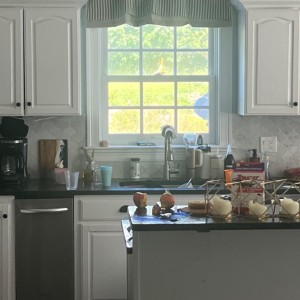Is a kitchen behind the dining room a good idea? Yes, it absolutely can be, and it’s a layout choice that comes with its own set of pros and cons. The key lies in understanding how this arrangement affects both functionality and the overall flow of your home. Let’s dive into the specifics of this particular room placement and what it means for your living space.

Why This Dining Room Layout Emerges: Historical Roots and Modern Applications
The idea of placing the kitchen behind dining isn’t a brand new concept. Historically, in larger homes, the kitchen was often tucked away, separate from formal entertaining areas. Think of grand estates where servants prepared meals in a less visible space. This kept the noise and potential mess of cooking out of sight of guests enjoying their meal in the dining room. This notion of separating preparation and consumption areas has lingered and continues to show up in certain home layout designs even today.
But the reasons for this layout are not always about recreating history. In modern homes, this kitchen location can arise from space constraints, architectural decisions, or simply the specific preference of the homeowners. Perhaps the main living area is best served by a large, open-plan design where the dining space flows directly off it, making an easy transition to adjacent rooms. You may find this in smaller homes or apartments where a separate kitchen tucked away from the living area feels less intrusive. It also works well for homes where the focus is on entertaining with minimal visibility of the kitchen’s often less than polished work in progress.
The Upsides: Benefits of a Kitchen Behind Dining Arrangement
There are advantages to this floor plan design. Let’s look at a few:
- Less Visual Clutter: A big perk is how well this setup hides the sometimes chaotic nature of cooking. With the kitchen tucked away, the dining area can maintain a more peaceful and visually tidy atmosphere. You’re not looking at the dirty dishes or food prep while you’re trying to enjoy a meal or engage in conversation. This separation helps create distinct zones within your home.
- Formal Dining Setting: If you enjoy formal dinners, this room placement can lend itself well to that. With the dining area closer to the entertaining zones, it helps create a more elegant and defined space for guests. The idea is that the dining room has its own special presence, uninterrupted by the bustle of the kitchen.
- Reduced Kitchen Noise: Sound can travel easily. This kind of layout can sometimes help to minimize the noise from kitchen appliances and cooking sounds, letting you enjoy conversation in the dining room in a much calmer manner. It’s a buffer, offering a barrier that some home layouts don’t have.
- Potential for Ample Counter Space: Having the kitchen tucked behind the dining room can sometimes allow for a larger kitchen area. By not being in a visible area, it allows the space to really be tailored to the cooking activities. This layout may prioritize the functional space of the kitchen itself, which in turn maximizes kitchen accessibility.
The Downsides: Challenges of a Kitchen Behind Dining Arrangement
Of course, there are always two sides. A kitchen behind dining also presents certain challenges:
- Inconvenient Flow: Bringing food from the kitchen to the dining area might feel a bit like trekking, especially if they aren’t right next to each other or if doors or hallways separate them. It’s easy to see how this might feel a bit less functional, especially with heavy dishes or a large family. It might not be conducive to a quick breakfast or informal family meals.
- Limited Interaction: One big drawback is the separation it creates. The person cooking might feel isolated from the conversations in the dining area. It’s not as easy to chat while working in the kitchen when the flow is through another room. This impacts social interaction and could be a deal breaker for many.
- Serving Challenges: The flow from kitchen to dining area needs to be well planned, otherwise it will be difficult to manage. You might find it difficult to get food from the cooking space to the dining space, especially during gatherings and large family dinners.
- Remodeling Limitations: If you’re thinking about remodeling, rearranging this kind of layout can be complex and often involves more extensive work than simply rearranging furnishings. It will impact plumbing, electrical and construction, requiring greater costs.
Maximizing the Kitchen Accessibility
Regardless of the pros and cons, you can make this home layout work well. The key is to think about kitchen accessibility and how the two rooms interact. Here’s how:
Enhancing Flow Between Rooms
- Wide Pass-Throughs: If structural changes are possible, consider wide doorways or pass-throughs that create a seamless connection between the two spaces. These will facilitate movement and prevent the feeling of a segmented space.
- Direct Routes: The shortest possible path is always best. When planning, evaluate how people will be moving between the kitchen and the dining area. Ensure the path is clear and unimpeded by furniture or other obstacles.
- Consider a Serving Hatch: A serving hatch is great as it can act as a mini passthrough for food, drinks or dirty dishes and is a wonderful way to create easier interaction with people in the dining area while you’re in the kitchen. It can be decorative too.
- Utilize Carts: A rolling cart can make serving meals and clearing dishes a breeze. It’s mobile and will help you keep your table looking its best throughout a meal. You can use it as both a serving tool and a clearing tool.
Fostering Interaction
- Open Design Elements: Where possible, create some openness. Even if the rooms are separated by a wall, the use of archways, open shelving, or cutouts can create the illusion of connectivity. This helps create sight lines and a more shared space.
- Ambient Lighting: Ensure that the lighting in the dining area compliments the lighting in the kitchen. This will help create a more unified feel and help connect the spaces and increase visual flow.
- Music Systems A good sound system is great for sharing music and making it part of the ambience of both areas.
Interior Design Touches That Connect Spaces
- Unified Color Palette: Use similar colors or patterns in both spaces to create a cohesive feeling. The flow of color from one room to another will draw them together.
- Shared Materials: Think about using the same flooring or countertop materials to bridge the gap between the two rooms. This can be a subtle but powerful way to reinforce the idea that these spaces are related.
- Consistent Decor: You can use artwork and plants to complement each other in both spaces. Using similar styles of décor will also reinforce the sense that they are part of the same overall space.
Real World Scenarios and Solutions
Let’s explore some specific examples.
Scenario 1: Small Apartment
A small apartment often has a compact floor plan design. If the kitchen is tucked behind the dining area, consider installing a pass-through window or a wide doorway. This allows for visual connection and makes it easier to carry plates. Utilize lightweight and easy-to-move dining furniture to maximize space and flexibility. The use of light colors in both spaces will also make the overall space feel bigger.
Scenario 2: Family Home
In a family home, kitchen proximity to the dining area is key, particularly for busy weeknights. To promote a better flow, create a kitchen island that faces toward the dining room, or incorporate a peninsula that functions as a serving counter. This helps keep the cook engaged with the family. Ensure that there is enough space for kids and parents to move around without feeling crowded, especially during meal preparation and clearing.
Scenario 3: Formal Entertaining Home
If you prefer formal entertaining, you can fully leverage the advantages of this room placement. Make the dining room the focal point with elegant furnishings, beautiful lighting, and decorative touches. You can use rich, deep colors to make it feel like a defined space. Ensure that the kitchen is easily accessed from the dining room for service. A well-placed service cart, a butler’s pantry or a serving hatch will all help create the functionality needed.

Making The Decision That’s Right For You
Choosing a home layout where the kitchen behind dining is a deliberate choice. There are a variety of factors that affect whether this choice is right for you. It’s not always a negative, despite how sometimes they might be perceived. It may offer you a lot of positives that you need to assess. These include:
- Lifestyle: Consider how you cook and entertain. Do you like informal gatherings or more formal dining? How much time do you spend in each area?
- Space Constraints: Look at the space you have. Is the space enough to comfortably accommodate both? Will one space feel cramped as a result of the other?
- Personal Preferences: Do you prefer open layouts or clearly defined rooms? How much visual separation do you prefer between these two areas of your house?
Ultimately, the best room placement is the one that fits your specific needs and lifestyle, not what’s necessarily considered the most traditional.
Frequently Asked Questions (FAQ)
Q: Can a kitchen behind dining make a home feel smaller?
A: It can if the spaces feel disconnected. However, with the right design – such as using open elements or consistent decor – the layout can still feel spacious and cohesive. The opposite is also true. A small kitchen can be visually separated and so can make the dining space feel more expansive.
Q: Is a kitchen behind dining more difficult to clean?
A: It doesn’t necessarily make cleaning more difficult, but it might add a bit of extra walking when you’re carrying dishes from the table to the sink. Good flow and using serving trolleys can help this.
Q: Does this layout suit families with young children?
A: It depends on your preferences. Some families prefer the separation for a quieter dining experience, while others might prefer a more connected layout where they can supervise children while cooking. Evaluate the needs of your family and go with that.
Q: Does a kitchen behind dining affect resale value?
A: It can have an effect. While it’s a valid design choice, some buyers might prefer a more open-concept kitchen. It’s always a good idea to consider how a particular choice will be perceived. However, this is balanced by the knowledge that a well-designed, clean and attractive kitchen is generally considered an important part of a home’s value.
Q: How can I make a kitchen behind dining feel less isolated?
A: Use connecting design elements such as similar flooring and paint colors or shared art or décor to make the two spaces feel more connected. Create open sight lines through doorways, pass-through windows, or archways. Make sure that there is a music system that both spaces can share.
Q: Are there specific architectural styles that lend themselves to a kitchen behind dining arrangement?
A: Historically, this layout was common in larger homes and estates. You might also see it in some mid-century modern homes or in smaller apartments where the primary design choice was to make the living area and dining areas feel expansive.
Q: How does this arrangement impact the overall flow of a home?
A: It can create distinct zones, which is great for some but not for others. Evaluate whether this creates a problem for the rest of your living areas and make sure that the flow of rooms works for how you live. It can create a more formal and less direct flow between the cooking and dining spaces, which can suit some styles of living, but will certainly not suit all.
Q: What should you focus on when designing a kitchen behind dining?
A: Always focus on creating a clear and efficient flow between the two spaces. Ensure that it feels connected and not disjointed. You need to optimize the functionality of each space while still making them feel visually part of the same house.
This article has been created using extensive research and decades of knowledge in interior design and home layout to provide a comprehensive overview of kitchens located behind dining rooms.

I’m a writer and culinary expert with over 10 years of experience in the kitchen. As a graduate of the Institute of Culinary Education and a passionate home chef, I created KitchenBreez.com to share my knowledge of kitchen techniques, cooking tips, and the best kitchen gadgets. Whether you’re a seasoned cook or just starting, my goal is to help you make your time in the kitchen more efficient and enjoyable.
